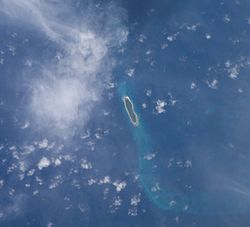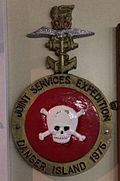Danger Island: Difference between revisions
Created page with "{{Infobox island |name=Danger Island |territory=British Indian Ocean Territory |picture=Danger Island ISS006-E-23425.jpg |picture caption=Danger Island (satellite picture) |la..." |
No edit summary |
||
| Line 6: | Line 6: | ||
|latitude=-6.383333 | |latitude=-6.383333 | ||
|longitude=71.238889 | |longitude=71.238889 | ||
|map=Danger Island in Chagos - map.svg | |||
|area=163 acres | |area=163 acres | ||
|population=Uninhabited | |population=Uninhabited | ||
Latest revision as of 20:24, 6 November 2024
| Danger Island | |
 Danger Island (satellite picture) | |
|---|---|
| Location | |
| Location: | 6°22’60"S, 71°14’20"E |
| Area: | 163 acres |
| Data | |
| Population: | Uninhabited |
Danger Island is the westernmost and the southernmost island of the Great Chagos Bank, which is the world's largest coral atoll structure, located in the Chagos Archipelago which constitutes the British Indian Ocean Territory.
The island
Danger Island is a flat island, a mile and a quarter long with a maximum width of 450 yards, covering just 163 acres. It is covered with tall coconut trees.
The island's name in all likelihood derives from the lack of a safe anchorage, which rendered every visit to this island dangerous for the ship and crew.[1] The closest land is Sea Cow Island, the southernmost of the Eagle Islands which lies ten miles to the north-northeast.[2]
History
There was never a permanent settlement on Danger Island, even at the time that the Chagos were inhabited (between the mid-18th and mid-20th centuries). However, occasionally plantation workers from other islands would be brought to this island to collect coconuts.

In 1975 there was an expedition to Danger Island by the Joint Services. The expedition members were taken by RFA Resurgent to the Eagle Islands and then by ketch and inflatable craft to Danger Island and to Three Brothers. The expedition made a topographical survey of the coral reef, an ecological survey of the corals on it and a study on the metabolism of the reef.[3] A reference collection of samples of the flora and fauna of the area was also undertaken.[4]
Following the Strict Nature Reserves Regulations issued on 18 September 1998, Danger Island, including its territorial waters and the reef surrounding it became a Strict Nature Reserve.[5]
Danger Island has also been identified as an Important Bird Area by BirdLife International. Birds for which the island is of conservation significance include red-footed boobies (3,500 breeding pairs) and brown noddies (11,000 pairs).[6]
Outside links
References
- ↑ Indian Ocean Pilot
- ↑ British Admiralty nautical chart 11000030 - 3 Chagos Archipelago, Scale 1:360 000
- ↑ Baldwin, EA (ed.) (1975), A report on the Joint Services Expedition to Danger Island in the central Indian Ocean, December 1974 to April 1975 Ministry of Defence Publication, London
- ↑ Chagos Islands coral collections
- ↑ 6: British Indian Ocean Territory
- ↑ Danger Island, Chagos Bank: Important Bird Areas factsheet (BirdLife International, 2012)
